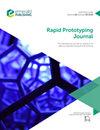熔融丝(FFF)用丙烯腈-丁二烯-苯乙烯(ABS)零件机械互锁粘接接头的试验研究
IF 3.6
4区 工程技术
Q1 ENGINEERING, MECHANICAL
引用次数: 0
摘要
目的增材制造有缺点,例如最大零件尺寸受到机器工作体积的限制。因此,如果需要一个比工作量更大的零件,则该零件是分零件生产并连接在一起的。在连接热塑性零件的许多方法中,考虑了粘合剂和机械互锁。本研究旨在表征和优化通过熔融丝制造(FFF)制成的丙烯腈-丁二烯-苯乙烯(ABS)试样上的机械应力粘合接头,以及内螺纹和外螺纹机械互锁,使接头强度尽可能接近基材的强度。设计/方法论/方法本研究描述了受试者的艺术状态,以证明本研究中计划的实验设计的决定是合理的。随后,本研究使用方差统计分析设计、执行和分析实验。输出变量为屈服强度和拉伸强度。输入变量是两种不同的氰基丙烯酸酯粘合剂、两种不同类型的机械联锁(截锥和圆柱销)以及每种类型机械联锁的尺寸。本研究使用了简单的析因实验来选择最佳的粘合剂和互锁,并使用响应面和陡峭上升法进行优化。结果:两种胶粘剂无统计学差异,但数据离散度不同。设计或屈服应力是选择最佳试样的决定因素,圆柱形几何形状在初始失效时表现出更高的阻力。由于应力集中器的存在,几何形状是至关重要的。具有较少应力集中器的圆柱形几何形状表现出更好的抗拉强度。最终,具有机械加固接头的试样,其特征为半径为5.45的圆柱形销 mm,高度4.6 mm表现出最大的拉伸强度和屈服强度。独创性/价值先前的研究表明,一个研究机会是FFF或熔融沉积建模中的粘合方法的结合,这不是一个常见的主题,而这项旨在丰富该主题的研究将粘合剂与机械联锁接头结合起来,并对FFF材料进行实验研究,以向该技术的设计者和制造商提供具有机械互锁的粘合剂接头的性能的未公开信息。本文章由计算机程序翻译,如有差异,请以英文原文为准。
Experimental study of adhesive joints with mechanical interlocking of acrylonitrile butadiene styrene (ABS) parts fabricated for fused filament (FFF)
Purpose
Additive manufacturing has disadvantages, such as the maximum part size being limited by the machine’s working volume. Therefore, if a part more considerable than the working volume is required, the part is produced in parts and joined together. Among the many methods of joining thermoplastic parts, adhesives and mechanical interlocking are considered. This study aims to characterize and optimize mechanically stressed adhesive joints combined with female and male mechanical interlocking on acrylonitrile butadiene styrene (ABS) specimens made with fused filament fabrication (FFF) so that the joint strength is as close as possible to the strength of the base material.
Design/methodology/approach
This study characterized the subject’s state of the art to justify the decisions regarding the experimental design planned in this research. Subsequently, this study designed, executed and analyzed the experiment using a statistical analysis of variance. The output variables were yield strength and tensile strength. The input variables were two different cyanoacrylate adhesives, two different types of mechanical interlock (truncated pyramid and cylindrical pin) and the dimensions of each type of mechanical interlock. This study used simple and factorial experiments to select the best adhesive and interlocking to be optimized using the response surface and the steep ascent method.
Findings
The two adhesives have no statistical difference, but they show different data dispersion. The design or yield stress was a determining factor for selecting the optimal specimen, with cylindrical geometry exhibiting higher resistance at initial failure. Geometry type is crucial due to the presence of stress concentrators. The cylindrical geometry with fewer stress concentrators demonstrated better tensile strength. Ultimately, the specimen with a mechanically reinforced joint featuring a cylindrical pin of radius 5.45 mm and height of 4.6 mm exhibited the maximum tensile and yield strength.
Originality/value
Previous research suggests that a research opportunity is the combination of bonding methods in FFF or fused deposition modeling, which is not a frequent topic, and this research to enrich that topic combines the adhesive with mechanically interlocked joints and studies it experimentally for FFF materials, to provide unpublished information of the performance of the adhesive joint with mechanical interlocking, to designers and manufacturers of this technology.
求助全文
通过发布文献求助,成功后即可免费获取论文全文。
去求助
来源期刊

Rapid Prototyping Journal
工程技术-材料科学:综合
CiteScore
8.30
自引率
10.30%
发文量
137
审稿时长
4.6 months
期刊介绍:
Rapid Prototyping Journal concentrates on development in a manufacturing environment but covers applications in other areas, such as medicine and construction. All papers published in this field are scattered over a wide range of international publications, none of which actually specializes in this particular discipline, this journal is a vital resource for anyone involved in additive manufacturing. It draws together important refereed papers on all aspects of AM from distinguished sources all over the world, to give a truly international perspective on this dynamic and exciting area.
-Benchmarking – certification and qualification in AM-
Mass customisation in AM-
Design for AM-
Materials aspects-
Reviews of processes/applications-
CAD and other software aspects-
Enhancement of existing processes-
Integration with design process-
Management implications-
New AM processes-
Novel applications of AM parts-
AM for tooling-
Medical applications-
Reverse engineering in relation to AM-
Additive & Subtractive hybrid manufacturing-
Industrialisation
 求助内容:
求助内容: 应助结果提醒方式:
应助结果提醒方式:


